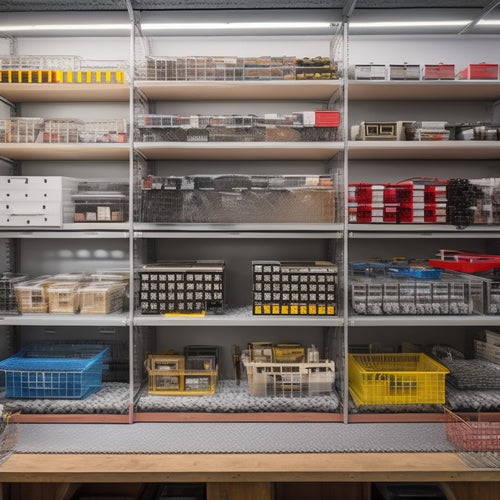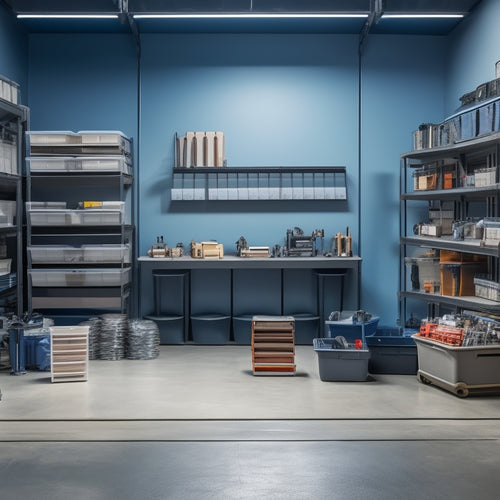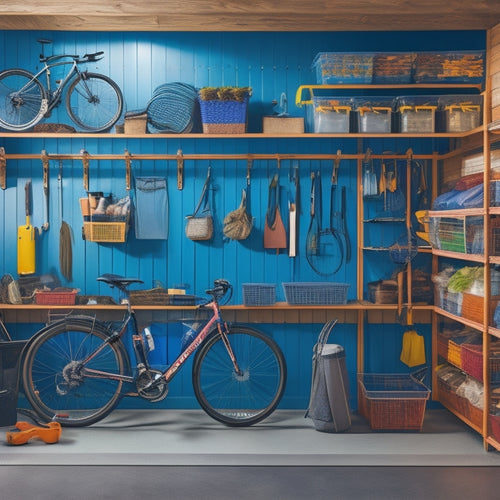
Design Your Dream Tool Storage System
Share
You're about to transform your workspace into a haven of organization and efficiency by designing a tool storage system that perfectly caters to your unique needs. Start by gathering all your tools, categorizing them, and creating an inventory list to identify what you need to keep and what you can let go of. Next, measure your available space and evaluate the room's layout and constraints. Consider factors like tool type and weight capacity when choosing a pegboard and accessories. Group tools logically, place frequently used tools at eye level, and optimize the layout for a smooth workflow. Now, you're ready to create a tailored storage solution that streamlines your workflow and boosts productivity - and that's just the beginning of your journey to the ultimate tool storage system.
Key Takeaways
• Categorize and inventory your tools to identify duplicates and prioritize what to keep, donate, sell, or prioritize in your storage system.
• Measure your workspace and design a storage system that fits its unique constraints and dimensions for maximum efficiency.
• Select the right pegboard material and accessories that fit your tool type and weight capacity, ensuring a seamless integration into your workspace.
• Design a pegboard layout that groups tools logically, places frequently used tools at eye level, and optimizes workflow for reduced search time.
• Maximize storage efficiency by utilizing storage cubes, vertical space, and labels to prevent clutter and ensure easy tool access.
Assessing Your Tool Collection
Take stock of your tool collection by gathering every item from your workshop, garage, or storage areas to get a thorough view of what you have and how it's currently organized. This step is essential in designing your dream tool storage system.
As you gather your tools, you'll likely notice that some are neatly stored in their designated places, while others are scattered all over the place. This is a great opportunity to practice tool categorization by grouping similar tools together, such as all your hand tools, power tools, or automotive tools.
Start by making an inventory list of every tool you have, including the type, quantity, and condition. This will help you identify what you need to store and how you can optimize your storage space. You might be surprised at how many duplicates you have or how many tools you no longer need.
Inventory management is key to maintaining a well-organized workshop. By taking the time to assess your tool collection, you'll be able to make informed decisions about what to keep, what to donate or sell, and what to prioritize in your storage design.
Measuring Your Available Space
Now that you've got a detailed inventory of your tools, it's time to assess the space where you'll be storing them, so grab your tape measure and let's get a precise calculation of your available space. Evaluate the room layout and identify any space constraints that might impact your storage design. Measure the length, width, and height of the area, as well as any obstructions like pipes, windows, or electrical outlets.
| Area | Measurement | Notes |
|---|---|---|
| Wall Space | 12 ft x 8 ft | Above workbench |
| Shelving Unit | 3 ft x 2 ft x 5 ft | Corner unit |
| Floor Space | 5 ft x 5 ft | Open area |
| Cabinet | 2 ft x 2 ft x 4 ft | Under workbench |
| Pegboard | 4 ft x 4 ft | Above cabinet |
Take note of any irregularities or challenges in the space, such as sloping ceilings or uneven floors. By accurately measuring your available space, you'll be able to design a tool storage system that maximizes efficiency and minimizes clutter. Remember to assess the flow of your workspace and how you'll be moving around the area. With precise measurements, you'll be able to create a tailored storage solution that meets your unique needs.
Choosing the Right Pegboard
Selecting the right pegboard for your tool storage system requires careful consideration of several factors, including the type of tools you'll be storing, the available space, and your personal preferences for organization and accessibility. You'll want to think about the weight capacity you need, as well as the durability and resistance to wear and tear.
Pegboard materials vary, with options like steel, aluminum, and MDF, each with its own strengths and weaknesses. Steel pegboards are sturdy and resistant to rust, while aluminum ones are lightweight and corrosion-resistant. MDF pegboards are a cost-effective option, but may not be as durable.
Aesthetic considerations are also important. Do you prefer a sleek, modern look or a more rustic, industrial vibe? Think about the color and finish of your pegboard, as well as the style of the hooks and accessories you'll be using.
You'll want your pegboard to fit seamlessly into your workspace, so consider the overall aesthetic you're going for. By taking the time to choose the right pegboard, you'll be well on your way to creating a tool storage system that's both functional and visually appealing.
Selecting Hooks and Accessories
As you design your dream tool storage system, you're now at the critical step of selecting hooks and accessories that will maximize your pegboard's potential.
You'll need to contemplate the type of hooks that will best hold your tools, taking into account factors like weight, size, and frequency of use.
Hook Type Options
You'll find that selecting the appropriate hooks and accessories is crucial for maximizing your tool storage system's functionality and efficiency. With so many options available, it's important to take into account the type of tools you'll be storing and the specific needs of your system.
When it comes to hook materials, you'll want to choose durable and rust-resistant options that can withstand heavy use. Look for hooks made from high-quality materials like stainless steel, aluminum, or heavy-duty plastic.
In addition to standard hooks, consider incorporating specialty hooks into your system. These can include:
-
Tool-specific hooks, designed to hold specific tools like hammers or screwdrivers.
-
Adjustable hooks, which can be customized to fit tools of varying sizes.
-
Rotating hooks, allowing you to maximize storage space and easily access your tools.
Accessory Placement Needs
With your tool storage system's layout and hook type options in place, careful planning of the placement of accessories is essential to ensure smooth tool retrieval and efficient workflow. You'll want to take into account the ergonomic considerations of your workspace, making sure that frequently used tools are within easy reach to minimize strain and discomfort. Think about the height and position of your accessories, considering the natural movement of your body as you work.
When selecting hooks and accessories, prioritize your personal preferences and work style. Do you prefer a clutter-free workspace or a more compact arrangement? Are there specific tools you use more frequently than others? By understanding your needs and habits, you can strategically place accessories to optimize your workflow.
For instance, you might place a pegboard near your workstation for quick access to hand tools or install a tool holder near the floor for heavier equipment. By thoughtfully planning the placement of your accessories, you'll be able to work more efficiently and effectively, freeing up time and energy for more important tasks.
Designing Your Pegboard Layout
Optimize your pegboard's potential by mapping out a strategic layout that streamlines your tool access and maximizes storage efficiency. As you design your pegboard layout, consider your personal style and how you move around your workspace. Think about the tools you use most frequently and the tasks you perform daily. This will help you create a layout that flows smoothly and saves you time.
To guarantee a well-organized pegboard, keep the following tips in mind:
-
Group similar tools together, such as all your screwdrivers or wrenches, to reduce searching time.
-
Place frequently used tools at eye level to minimize stretching and bending.
-
Reserve the top and bottom rows for less frequently used items, like specialized tools or accessories, to keep your most-used tools easily accessible.
Building Your Custom Pegboard
Now that you've mapped out a strategic layout, it's time to bring your custom pegboard to life by selecting the right materials and hardware that fit your design.
You'll want to choose a pegboard material that suits your style and needs, such as a durable metal or a sleek wooden board. Consider the Pegboard Aesthetics, like the color, finish, and texture, to guarantee it blends seamlessly with your workshop's décor.
When it comes to hardware, you'll have a wide range of Customization Options to explore. From hooks and bins to magnetic strips and tool holders, the possibilities are endless.
Think about the types of tools you'll be storing and the frequency of use. This will help you determine the most practical and efficient hardware to include. For instance, if you have a lot of small parts, consider adding bins or containers to keep them organized.
Maximizing Storage Efficiency
You can squeeze every last bit of storage out of your pegboard by strategically locating frequently used tools in easy-to-reach zones. This will save you time and energy when working on projects, as you won't have to dig through cluttered shelves or drawers to find what you need.
To maximize storage efficiency, consider the following tips:
-
Use Storage Cubes: These versatile containers can be attached to your pegboard, providing a dedicated space for small items like screws, nuts, and bolts. Label each cube so you can quickly identify what's inside.
-
Optimize Vertical Space: Make the most of your pegboard's vertical real estate by using hooks, bins, and shelves to store items of varying sizes. This will help keep your workspace organized and prevent clutter from building up.
-
Group Similar Tools Together: Store tools of the same type or function in close proximity to each other. This will help you quickly find the tool you need and prevent you from having to search through your entire pegboard.
Frequently Asked Questions
Can I Customize My Pegboard With a Non-Standard Size or Shape?
Like a master sculptor chiseling a unique masterpiece, you can craft your pegboard to fit your needs, with custom dimensions and unique configurations that reflect your one-of-a-kind style, because, yes, you can customize it to your heart's content.
How Do I Protect My Tools From Rust and Corrosion in Storage?
You'll want to prioritize rust prevention and corrosion control by storing tools in a dry, well-ventilated area, using rust-inhibiting sprays or coatings, and keeping them clean and dry before storage to prevent moisture buildup.
Are There Any Tool Storage Systems Suitable for Outdoor or Garage Use?
You're not alone in the wild, left to battle the elements, because yes, there are tool storage systems built to brave the outdoors, like weather-resistant cabinets and outdoor shelving, designed to shield your tools from harsh weather conditions.
Can I Use a Pegboard for Storing Small Parts and Accessories?
You can definitely use a pegboard for storing small parts and accessories, creating a customized Pegboard Layout that suits your needs. This will help you achieve precise Accessory Organization, keeping everything within easy reach and freeing up valuable space.
Are There Any DIY Tool Storage Systems Compatible With Existing Shelving Units?
You can easily upgrade your existing shelving units with DIY tool storage systems using shelf adapters that fit seamlessly, and custom inserts designed to hold specific tools or parts, maximizing your storage space efficiently.
Related Posts
-

10 Essential Steps for Small Parts Bin Storage
To optimize your small parts bin storage, start by defining your storage needs and goals, considering factors like av...
-

How to Maximize Storage Space With Parts Storage Bins
To maximize storage space with parts storage bins, start by evaluating your available storage space and examining you...
-

Garage Wall Storage Ideas to Boost Productivity
You can enhance your garage's productivity by capitalizing on your ceiling height with overhead racks, storing bulky ...


